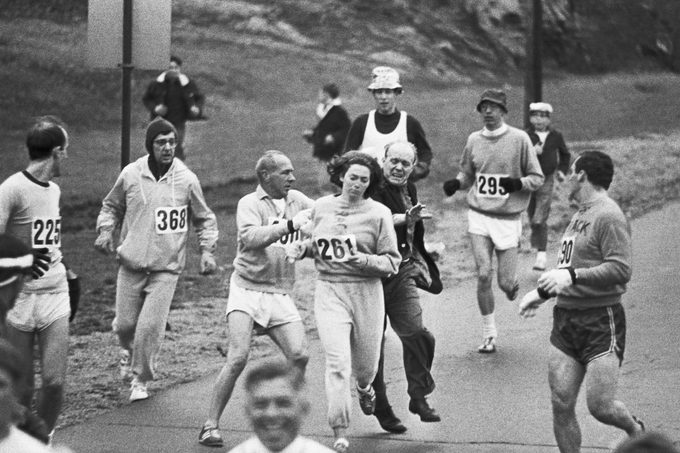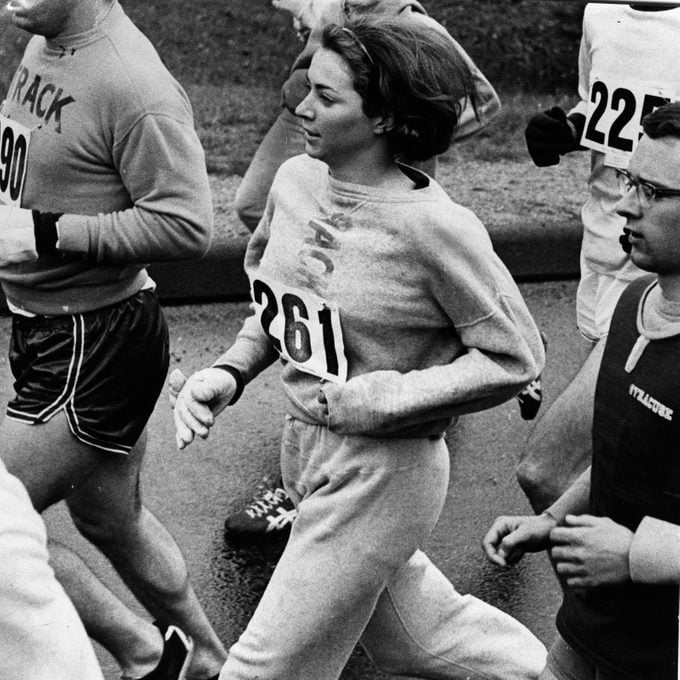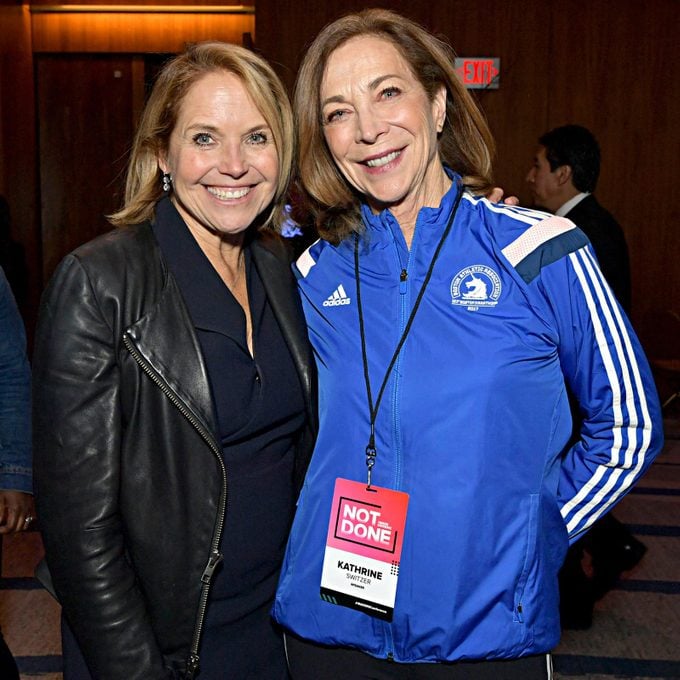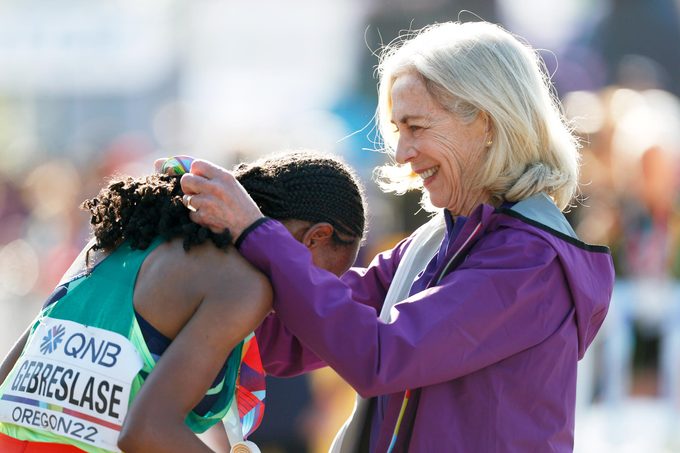In 1967, She Broke Rules To Run the Boston Marathon—Today, She Says: ‘Women Have Hidden Potential’
Updated: Apr. 12, 2024

Kathrine Switzer was the first-ever woman to register for the Boston Marathon. Almost 60 years later, she remains a force empowering women and girls to move.
Kathrine Switzer may not have set out to become a champion for women’s athletics and equality, but she didn’t shy away from it, either. When Switzer talked her coach into training her for the Boston Marathon in 1967, another five years would pass before women were formally allowed to participate in the race.
It was, of course, an important era for the advancement of American woman in general. In her 2017 memoir Marathon Woman, Switzer tells the story behind the famous photograph of the race commissioner trying to pull her out of the race—an image some female runners, as well as many female professionals, often refer to as a symbol of strength and perseverance. In an exclusive interview with The Healthy by Reader’s Digest ahead of the 2024 Boston Marathon on April 15, Switzer revealed that the bib she wore that day donning the number 261 “is on its way to the Smithsonian, which is really wonderful.”
Today at age 77, Switzer leads 261 Fearless, a global nonprofit she founded. “The concept is to get a woman in a community really well trained as a coach—or two or three women—and they start a club or a group with the proper background and tools. Then the group coalesces, and they run with all ages, all abilities, no judgment.” 261 Fearless is a beneficiary partner of the November Every Woman’s Marathon, which is described as “the only marathon in the U.S. for women, by women, designed to unite runners of all levels, abilities, and backgrounds in an inspiring, community-driven wellness weekend.”
Of Every Woman’s Marathon, Switzer says, “We are really, really excited that we’re one of the designated charities. We’re going to give this race body and soul.”
Prepare to be inspired by this living legend—who, may we add, is every bit as feisty and energetic as we’d hoped. We snagged time with her between hiking trips to New Zealand, where she spends part of the year.
Stay inspired—and stay well—when you subscribe to The Healthy by Reader’s Digest newsletter

The Healthy by Reader’s Digest: It’s exciting to have this conversation with you the same week the championship between Iowa and South Carolina became ESPN’s most-viewed college basketball game, men’s or women’s. Was gender equity one of your motivations to get into the race? Did you know you were making a daring choice that day?
Kathrine Switzer: Look, when I first ran the Boston Marathon, it was more of a gift from my coach [Arnie Briggs] to me because he and I had argued for many, many months about whether a woman could run a marathon or not. This was when I was a student at Syracuse University. He was a volunteer coach ex-marathoner. He was the University mailman, and he was a really, really humble, modest guy. He had run Boston 15 times, and the day in his life when he ran the Boston Marathon was the day he was somebody. So it was just wonderful to hear his stories.
But after a while I got tired of him [laughs], and I said, “Well, let’s quit talking about running it, and let’s do it.”
And he said, “A woman can’t possibly do a marathon.”
And I said, “Oh, come on, we have been running 10 miles a night in a blizzard. We can do this.”
“A woman can’t do it,” he said. “If any woman could, I believe you could—but even you would have to prove it to me.”
I went on and on about it. I said, “Listen: Women throughout history have actually run marathons.” I mean, not many, six. And at Boston, a woman ran the year before I did. She jumped out of the bushes and ran the race. He didn’t believe it—many people didn’t believe it—but I saw it was in the newspapers. I knew a couple of guys who had had seen her in the race.
So we ran in practice, and the day we went to run 26.2 miles, when we were finishing up, he said, “You look really great.”
I said, “I don’t think we went far enough. Let’s do another five-mile loop.”
He said, “Can you do another five?”
I said, “Sure, come on. Can’t you?”
So we finished up, now it’s 31 miles, and by that time he was weaving all over the road—he was gone. When we finished, I clapped him on the back and said, “We did it! We’re going to Boston!”
And he fainted. When he came to, he said, “Women have hidden potential in endurance and stamina.”
It was a gift when Arnie helped me sign up for the race. He insisted I register for it. I said to him, “You know, I’m going to be noticed in Boston if I wear a bib.”
He said, “You have to wear a bib. It’s against the rules not to. You have to pay your registration. This is a serious race.”
So I said, “OK, I guess I’m gonna be noticed.”
And he said, “I’m proud of you.” It was really amazing. So I knew I was going to be noticed, but I went low-key. It was raining and snowing and sleeting, and so I was in my baggy warm-up suit, but underneath I had on a really cute-looking shorts and top. I was kind of proud of myself, but we were all wearing everything we owned. It was so miserable.
All the guys knew I was a woman. They were excited about it, and welcoming, saying, “I wish my wife would run, I wish my girlfriend would run!”
So you know, basically I was just there to run the race. That’s all I wanted to do: Put my head down and run. So I had no idea was making history. I thought I was following the rules. I thought it was no big deal.

The Healthy: So many of us have seen that iconic photo of you in the race—actually, a series of images a photographer caught. What was going through your mind as a 20-year-old woman, with grown men who were coming at you pretty aggressively?
Kathrine Switzer: What happened is that [at the] mile-and-a-half [point] is when the press truck came by. The race director saw me and absolutely lost his temper and attacked me—and he did it in front of the press truck! I mean, we wouldn’t even be having this interview if he hadn’t done that. He was out of control and my boyfriend, who was one of the guys who was running with me, decked the official … [and] screamed, “Run like hell!” And down the street we went again.
Also the press truck was haranguing me. All the guys on the bus—men, all men—were shouting at me: “What are you trying to prove? Are you a suffragette?”
Finally, I shouted back: “I’m not going to quit. You might as well go to the front of the race where you belong.”
When they left, I turned to Arnie, and I said, “I’m finishing this race in my hands and my knees if I have to.”
Arnie said, “OK, we’re going to slow down. We’re just gonna make sure we finish the race. That’s going to be our objective.”
So the series of pictures were literally flashed around the world before I even finished the race. As a journalism student, the aftermath of this was fascinating. Does the event make the history, or just capturing the moment on film make history?

The Healthy: Incredible. How had you gotten into running?
Kathrine Switzer: My dad. I went to a little country day school, there were only like 60 kids in the entire school. I was going into high school, which was eighth grade in those days, and there were 1,500 kids in this high school. I mean, they were grown up kids, you know, they were cool. And I wasn’t cool. I wanted to be a cheerleader because they were kind of pretty and popular. That’s really all there was for women.
And my dad said, “Oh honey. You don’t want to be a cheerleader. They cheer for other people. You want people to cheer for you.”
And I said, “What?”
He said, “I went to the PTA meeting. Your school has something new: It’s called field hockey. I only know that there they run, and you can run,” he said. “Why don’t you try for that field hockey team?”
I said, “Well, I don’t even know anything about it.”
He said, “If you ran a mile a day, you’d be the best player on the team.” My father was a very motivating guy.
I said, “I cannot run a mile!”
He said, “Sure, you can. Come on, let me show you. Just finish. It’s about finishing.”
So we measured the mile, I did it, and I said, “Oh, Dad, I did it!”
He said, “Yay! Guess what?”
I said, “What?”
He said, “Now you do it every day.”

Amanda Gorman Wants You To Run
The Healthy: So that’s how it started for you. Women’s fitness and athleticism arguably have come a pretty long way, and it’s exciting to see the Every Woman’s Marathon making a marathon more accessible. What’s your perspective on this?
Kathrine Switzer: You said “arguably,” but it is not arguable. It’s absolutely unbelievable. I mean, just look at it in my own lifetime, OK? Let’s say it’s been 55 years since women were allowed to run in a marathon. It’s only been 40 years since we’ve had an Olympic marathon. But now? Fifty-eight percent of all participating runners in the United States are women. They account for 85% of the retail sales—you know, clothing and shoes. I just talked to the guys at the New York City Marathon. Over half the field is now women. Do you know what that accounts for? Millions of dollars. It’s a huge economic impact.
But OK, let’s put that over here. The point is, it is not unusual anymore for a woman to run and to be accepted or to take part in sports, or to move her body, or to be out in public moving. I mean, there’s still some some slideback. Safety is still an issue for women when we go outside, particularly alone and in the dark. But men have had an Olympic Games for 3,000 years. If women have only had running events in the Olympic Games, let’s say for the last 50 or 60 years, you’ve got to understand: You’ve overcome eons and eons of backward thinking. The sense of freedom and the equality of women in the sport, and the equality of women in general in society. And I definitely think sports has led this charge.
The Healthy: You’ve seemed to stay healthy and active over the years. What’s your favorite way to exercise today?
Kathrine Switzer: Well absolutely it’s running. I mean, it’s easy, cheap, convenient and totally accessible. You go out the door, boom, you’re running and every second counts. I don’t have to drive to gym. I don’t have to drive to a pool. Why waste the 15 minutes to get to a gym and park the car when I could use every moment? I’ve even taken now to putting on a backpack and making it very heavy by putting all my groceries and stuff in it, and using that for really good kind of quad work just from carrying it around.
I also make sure I have a very big living room. I push all the furniture back and do all my stretching, my Pilates and my weight work on my living room floor, saving time, combined with watching Turner Classics or something. Just me and movement is my favorite form of exercise.
The Healthy: How far do you try to run each day?
Kathrine Switzer: I would say every day I do at least at least 50 minutes to an hour [and] five [minutes], around that range. Basically I run how I feel. Some days when I’m really tired, I just take it easy, but then I find myself moving into it and picking it up. Then one day a week, a long run, perhaps an hour and a half.
The Healthy: What’s another form of self-care you refuse to skip?
Kathrine Switzer: Good food. Milk has been an enormous, enormous part of my life. My dad was grew up on a dairy farm, and … I remember my brother and I drinking at least a quart of milk each day. I still have a glass of milk, at least one every night before I go to bed, because it helps you sleep and rebuilds the tissue. You look at the calcium, potassium and magnesium content of of milk, it’s overwhelming. I look at myself and say, You know, you’re 77, you’re still out there running sometimes three and four hours. Or I do a 10K hike in 57 minutes, and people tell me, “And you’ve never had a stress fracture!”
I eat actually extremely healthy food, so almost everything is fresh. That’s why I went berserk on this [most recent New Zealand] trek. We went four days, and the dehydrated food came—you know, all these bars and processed stuff. But I had packed four huge, thick almond butter and honey sandwiches and bananas, and my powdered milk.
Everybody laughed at me, but I gotta tell you that at the end of that walk, I was the best-fueled person there.
- Does Walking Lower Blood Pressure? Here’s What a Cardiologist Says
- Higher Intake of This Nutrient May Lower Violent Crime Rates, Says New Study
- Here’s How Much Sugar Is Really OK Per Day, with Expert Doctors’ Guidelines
- I Ate Pasta Every Day for a Week—Here’s What Happened
- If Katie Couric and This Body Part Are Still Synonymous? “I’m OK with It,” She Says
This interview has been edited for length and clarity.

















